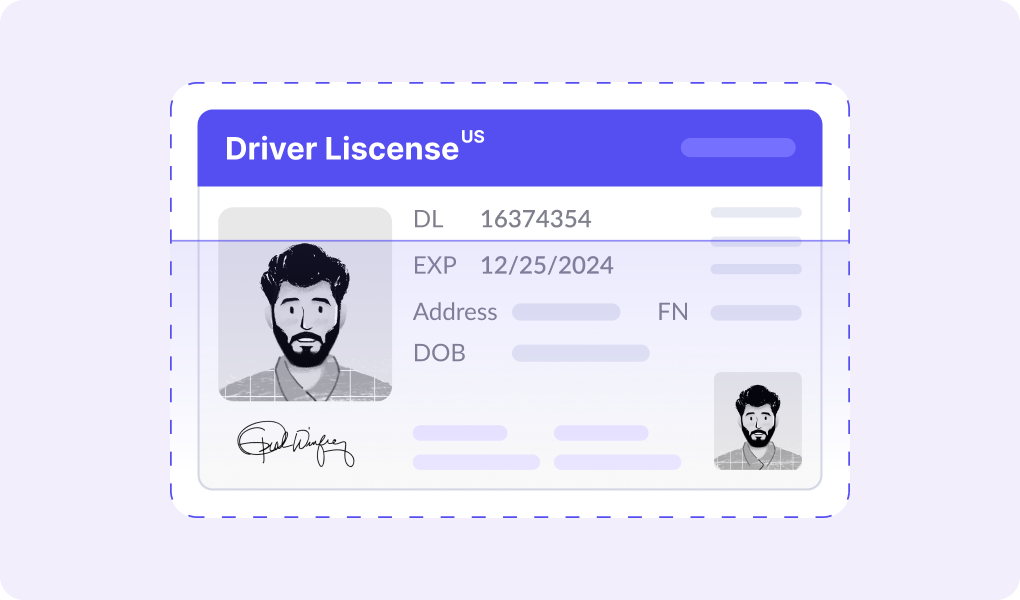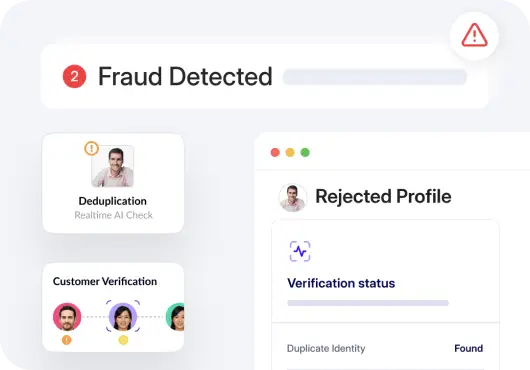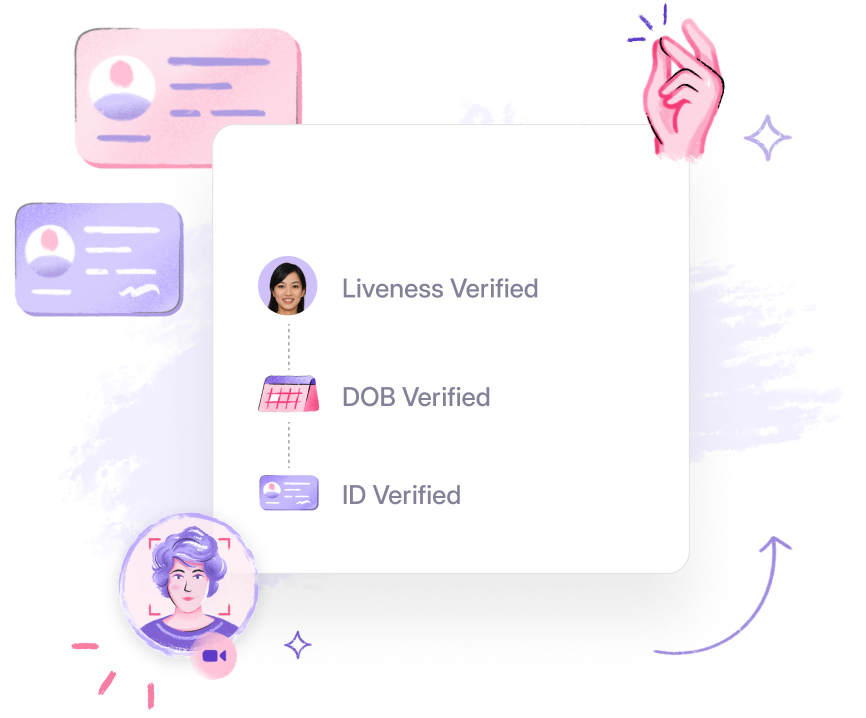In high-risk industries such as finance, healthcare, and government, ensuring the accuracy and security of identity verification processes is crucial. In such industries, two key technologies, Optical Character Recognition (OCR) and Identity Document Processing (IDP), are often used to verify identities and prevent fraudulent activities.
While both methods share the goal of verifying identities, they differ significantly in their approaches and capabilities. Understanding the differences between OCR and IDP is essential for implementing effective identity verification and Anti-Money Laundering (AML) compliance measures.
In this blog, we will delve into the distinct features and applications of OCR and IDP, providing insights on how to choose the best solution for your organization’s specific needs and ensuring the highest level of identity verification and AML compliance.
What is OCR (Optical Character Recognition)?
Optical Character Recognition transforms images of text (they may be typed, handwritten, or printed) into editable and searchable digital data.
Here is how Optical Character Recognition (OCR) technology works.
- Scanning: The process begins with scanning the document using a scanner or taking a clear picture with a camera. This step captures the document’s image.
- Recognition: Sophisticated algorithms analyze the scanned document image, segmenting it into individual characters. The OCR engine then cross-checks these characters against a vast database of fonts and styles to recognize each letter, number, and symbol.
- Data Extraction: The recognized characters are assembled into words, lines, and paragraphs, creating a digital text file. The software can save this data in various formats, including plain text, Word documents, or PDFs.
OCR’s applications are widespread across many industries, including financial services, fintech, cryptocurrency, and online gaming. It helps with tasks like:
- Workflow Automation: OCR is commonly used to automate data entry workflows. For example, it can extract information from scanned documents, such as customer identification documents (e.g., IDs, passports, driver’s licenses), financial statements, and age verification documents.
- Streamlining Processes: OCR software plays a crucial role in streamlining processes by making tasks like loan applications, account opening, user onboarding, and KYC verifications faster.
- Fraud Prevention: OCR technology helps prevent fraud by timely identifying suspicious activity within documents.
- Improved Efficiency: OCR reduces manual data entry resources and minimizes associated errors, resulting in improved efficiency.

Some industry-specific uses are as follows.
Financial Services
Optical Character Recognition streamlines tasks like loan applications and account opening. It also helps with fraud prevention by automatically extracting data from customer identification documents and financial statements.
Fintech
OCR software enables faster onboarding for new users and automates data entry in mobile banking apps.
Cryptocurrency
The technology expedites user verification (KYC) processes by capturing information from passports and driver’s licenses.
Online Gaming
It verifies player identities and safeguards against underage gambling by extracting data from age verification documents.
What is IDP (Intelligent Document Processing)?
Intelligent Document Processing takes document processing to a new level. It goes beyond simply extracting text like OCR software. IDP leverages artificial intelligence (AI) to understand the meaning and context within documents. It also utilizes natural language processing to better understand the semantics of text in documents.
This allows intelligent document processing to capture data and classify documents, validate information, and even make intelligent decisions based on the extracted content.
Here is how IDP works.
Advanced Document Analysis
- IDP uses AI to intelligently analyze the structure of a document.
- It can identify different sections within a document, such as name, address, or expiry date.
- Additionally, intelligent document processing can categorize documents by type, differentiating between a passport, invoice, or bank statement.
Data Extraction
- IDP goes beyond simple text capture.
- It extracts specific data points based on their location and context within the document.
- The technology extracts data from both structured and unstructured documents.
- It recognizes and validates data accuracy, ensuring reliability.
Processing
- IDP applies machine learning to refine data interpretation continually.
- It uses natural language processing to understand context, improving decision-making accuracy.
- IDP validates the extracted data against predefined formats or external databases to ensure accuracy.
- It can also enrich the data by adding missing information from other sources.
- Finally, IDP can trigger automated actions or decisions based on the extracted and validated data. This could include automatically populating forms or initiating workflows based on the document content.
IDP can, therefore, easily process structured, semi-structured, and unstructured data. IDP has widespread applications.
Financial Services
- Intelligent document processing automates the extraction and processing of data from loan applications and other client documentation.
- It enhances compliance processes by accurately analyzing and storing sensitive information.
Fintech
- IDP helps fintech companies quickly bring on new customers by automating customer onboarding processes.
- It also quickly and accurately handles large amounts of transaction data, which helps in making decisions instantly.
Insurance
- Intelligent Document Processing (IDP) improves the claims process by pulling data from claim forms and other documents.
- It also helps find fraud by looking at patterns and things that don’t match the documents submitted.

OCR vs. IDP: A Comparative Analysis
Both Optical Character Recognition (OCR) and Identity Document Processing (IDP) technologies share some common benefits, including:
- Data Extraction: Both OCR and IDP can extract data from documents, making it easier to process and utilize the information.
- Data Processing: They both facilitate the processing of data, including tasks such as invoice processing and creating digital documents.
- Cost Savings: By reducing the need for manual data processing, both OCR and IDP can help organizations save resources and costs.
Despite these similarities, OCR and IDP have distinct strengths and use cases. While both technologies assist with document processing and data validation, they differ in their approaches and capabilities.
Optical Character Recognition (OCR)
- Optical Character Recognition mainly extracts text from scanned documents and images.
- It changes this text into a digital form you can search and edit.
- Optical Character Recognition software is mainly useful for document archiving, creating accessible digital libraries, and basic data entry.
Intelligent Document Processing (IDP)
- Intelligent Document Processing uses OCR software but does more than capture text.
- It also uses Artificial Intelligence (AI) and Machine Learning (ML) to understand the document’s context and structure. In addition, it uses Natural Language Processing (NLP).
- With this additional help, IDP can also extract specific data points like names, addresses, invoice amounts, and dates.
- It can categorize documents by type (e.g., invoice, passport, or contract) due to its advanced context understanding.
- It also validates extracted data against predefined formats or external databases to ensure accuracy.
- The technology can even enrich data by adding missing information from other sources.
- IDP helps you implement intelligent automation based on the extracted data (e.g., populating forms and company databases or initiating approvals).

Limitations of OCR
- The first limitation comes in the form of limited functionality. OCR excels at converting images to text but struggles with complex documents or unstructured data.
- Then, there is a slight chance of OCR being more error-prone. OCR accuracy can be affected by poor-quality scans, unusual fonts, or handwritten text. Manual intervention is often needed to correct errors.
- Finally, the limitation of limited context. OCR doesn’t understand the meaning of the extracted text.
While Optical Character Recognition (OCR) is highly effective for straightforward text recognition and conversion tasks, it does not understand the context of the extracted data. It can struggle with unstructured documents where the layout varies significantly or where the document includes elements like images and complex tables. Optical Character Recognition requires more manual intervention to correct errors and is less adaptable to different document types without additional configuration.
Here’s how IDP overcomes these limitations:
- IDP understands the context. For this, it uses natural language processing and machine learning models. The IDP technology interprets the layout and content of documents, making it suitable for complex documents, tables, and even handwritten text.
- Then, there is improved accuracy, leading to fewer errors. IDP systems more accurately recognize and interpret complex data. IDP leverages intelligent automation and machine learning to continually improve its accuracy and handle variations in document formats.
- After that comes the benefit of extending automation. IDP automates data extraction and associated tasks, reducing manual effort and improving efficiency.
- All of these lead to efficient workflows. IDP can trigger automated workflows based on extracted data, streamlining processes.
IDP tackles many of OCR’s weaknesses by using powerful tools like NLP, ML, and AI. Natural Language Processing (NLP) helps in the extraction, interpretation, and contextual understanding of text. These help IDP handle structured, semi-structured, and unstructured documents. IDP systems improve over time through learning models, can automatically correct extraction errors, and provide more accurate data handling.
There is another technology you can know about RPA. Robotic Process Automation is a technology that uses software bots to automate routine and repetitive tasks. By integrating robotic process automation with IDP systems, businesses can automate complex document-based processes.
IDP can interpret the context of the data it extracts, making it highly effective for industries requiring high levels of accuracy and cognitive understanding, such as legal, healthcare, and financial services.
Importance of IDP for Identity Verification and AML Compliance
Identity verification is paramount for businesses. It confirms that customers are who they say they are. Thus helping prevent fraud and build trust. Following Anti-Money Laundering (AML) rules is just as relevant. Intelligent Document Processing provides a robust solution for both tasks.
Below is how IDP enhances identity verification and AML compliance.
- IDP correctly extracts information from identity documents. It cuts down the risk of mistakes by automating the capture and checking of data.
- It processes documents quickly, allowing for instant identity checks and compliance checks.
- IDP systems can adapt to new and evolving compliance regulations. They do this by updating their data models and rules. This makes sure that compliance is always there with minimal human intervention.
- By automating document processing, IDP frees up resources, allowing compliance staff to focus on more complex tasks and analyses.
Here is how you benefit from IDP:
- IDP enhances data accuracy, which is crucial for meeting the stringent compliance standards set by US regulators.
- As IDP systems are efficient, they minimize the time and labor traditionally required for manual document processing.
- Companies can better detect and prevent fraudulent activities with improved processing capabilities, which enhances AML efforts.
- IDP integrates seamlessly with existing systems, which allows for a scalable solution that grows with the company and its compliance needs.

How HyperVerge’s Solutions Can Help
HyperVerge’s innovative AI-powered OCR solution offers IDP capabilities and is equipped to extract information from both structured and unstructured documents.
One of the best things about HyperVerge’s system is that it can learn from just a handful of samples. This rapid adaptability is efficient and highly accurate, thus revolutionizing how you approach document processing.
- HyperVerge’s OCR technology works seamlessly to understand and categorize content from any document.
- The system needs only a week to train on new document types, ensuring businesses can quickly adapt to new data processing requirements.
This quick turnaround and minimal sample requirement significantly reduce the time and resource investment typically associated with deploying AI-driven document processing solutions.
Benefits of HyperVerge’s OCR and IDP Integration
The integration of OCR with IDP technologies in HyperVerge’s solutions offers numerous benefits:
- You experience enhanced accuracy in data extraction, which means minimized errors that otherwise lead to costly corrections and compliance issues.
- By processing even complex documents quickly, you can react faster to changes in the market and new rules.
- Our technology works with numerous document types, making it a versatile tool for various industries.
Conclusion
For heavily document-specific functions, you need efficient ways to extract information. While both OCR and IDP play a role, IDP offers a more intelligent and feature-rich solution.
Major differences between OCR and IDP can be summarized as follows:
- OCR is primarily used to convert images of text into machine-readable text, focusing mainly on digitization without understanding context.
- IDP leverages OCR capabilities but incorporates AI to understand and process data from documents intelligently, handling complex and varied formats effectively.
If you are aiming to harness the full potential of your document processing systems, adopting IDP technologies is not just an improvement; it’s a necessity. HyperVerge’s solutions represent the forefront of this technology.
By integrating advanced IDP systems, businesses can achieve greater accuracy, efficiency, and compliance.
Discover how HyperVerge’s advanced OCR and IDP solutions can revolutionize your document management processes. Visit HyperVerge’s OCR Software to explore the possibilities and start your journey towards smarter document processing today.





